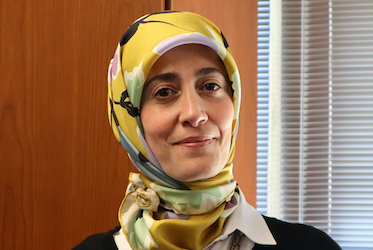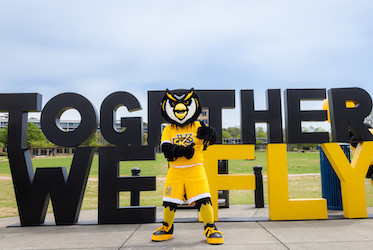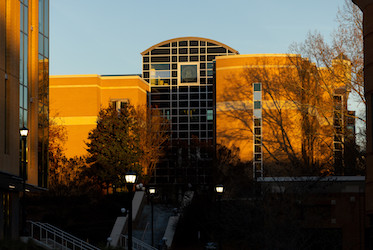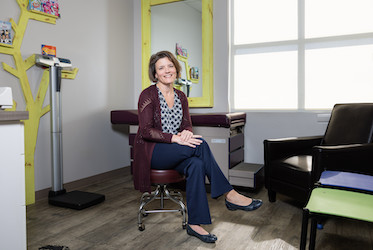
Pumpkins Away!
KENNESAW, Ga. | Oct 25, 2019
Engineering students gain hands-on experience in annual Pumpkin Launch

Two years ago, Anna Mitchell was watching her neighbor build a trebuchet in his front yard ahead of Kennesaw State University’s Pumpkin Launch and envisioned herself in his place.
Now a first-year mechanical engineering student in the Southern Polytechnic College of Engineering and Engineering Technology, Mitchell achieved that goal this week by leading a team of peers in the University’s ninth annual Pumpkin Launch.
“I remember thinking how awesome it was to see the launcher come together and wanting to build one myself,” said Mitchell, whose sister also studies mechanical engineering at Kennesaw State. “Now, I’m happy to say I have the same experience.”
Held on KSU’s Marietta Multipurpose Fields, the launch is the culmination of a semester-long project for students in the Introduction to Mechanical Engineering course. Under competition rules, students must use their engineering skills to build launchers that are “purely mechanical,” meaning they could not use chemical propellants or electrical power. Accepted devices include trebuchets, catapults, ballistas and slingshots, all of which must fit into a designated space with a maximum counterweight of 1,500 pounds. Each of the 30 teams was allowed three attempts to launch a pumpkin, and awards were given for distance and pumpkin decoration.

Two weeks prior to launch day, the teams were subjected to a critical design review, which amounts to a classroom presentation in which they defend the merits of their design and the research that went into its selection. After extensive research, Mitchell’s team, Gourd of the Rings, settled for a swinging counterweight trebuchet design after determining it to be the most reliable and efficient. They estimated their launches to eclipse 360 feet in perfect conditions.
On launch day, Gourd of the Rings fell short of that estimate, though the students immediately went to work making adjustments to improve subsequent launches.
“It’s a lot of problem solving,” said Mitchell, as her team added more counterweights and adjusted the angle of their release pin. “It’s almost a game. To me, it’s really rewarding to brainstorm solutions as a team and see all of our ideas come together in one project that can actually launch a pumpkin is pretty amazing.”
Further down range, Torque Team was making adjustments of their own to improve their second launch of the day after the first attempt fell short of expectations. The team chose the floating arm trebuchet, which features a vertical “drop channel” down the center of the trebuchet. When triggered, gravity pulls a weighted bar downward, dragging the arm of the trebuchet forward along a horizontal guided track and launching the pumpkin downrange. Team captain Marc Swasey said the horizontal motion allowed them to maximize launch potential with the limited amount of weight available.
With just 300 pounds in counterweights, Torque Team saw their second launch sail nearly 235 feet as dozens of onlookers roared with applause. The distance, measured by Department of Civil and Construction Engineering students and faculty, was the longest of the first heat.
“Troubleshooting and redesign are very big parts of engineering,” said David Veazie, professor of mechanical engineering. “Not everything will go right the first time. The teams that are able to troubleshoot and make adjustments on the fly are often the ones who prove successful on launch day.”

Such was the case for Family Joules, which frequently retooled its design ahead of launch day. Team member Nelson Jones said the team’s biggest hurdle was learning the durability and limits of the material need to complete their swinging counterweight trebuchet. Early versions of their design used a hollow metal tube as the axle, but this quickly bent under the weight of their arm. The team swapped the hollow tube for a solid piece of cold rolled steel. Family Joules also used WD40 and pillow block bearings on their pivot points to reduce friction and allow the machine to move in a more fluid motion.
Their first launch of the day surpassed Torque Team with a measured distance of about 270 feet. Subsequent launches landed 373 feet and 429 feet, respectively, earning them the distance crown.
“It’s just great knowing that I can use my skills the very first year and show professors that I’m capable of doing these things,” said Jones, who chose KSU due to its reputation for hands-on engineering experiences. “Just having a little taste of it is going to give me that confidence in the long run that I can see this through and apply what I’m learning.”
Following the launch, two teams received awards:
- Family Joules for distance with a launch of 130 meters (429 feet);
- Typhoons for pumpkin decoration.
—Travis Highfield
Photography by David Caselli
Related Stories

KSU researcher creates environment that allows students to thrive

Kennesaw State supporters exceed expectations during first Giving Day event

Kennesaw State partnership equips local entrepreneurs with tools for success

Kennesaw State researcher applies mathematical modeling expertise to health care systems
A leader in innovative teaching and learning, Kennesaw State University offers undergraduate, graduate and doctoral degrees to its more than 45,000 students. Kennesaw State is a member of the University System of Georgia with 11 academic colleges. The university’s vibrant campus culture, diverse population, strong global ties and entrepreneurial spirit draw students from throughout the country and the world. Kennesaw State is a Carnegie-designated doctoral research institution (R2), placing it among an elite group of only 7 percent of U.S. colleges and universities with an R1 or R2 status. For more information, visit kennesaw.edu.















